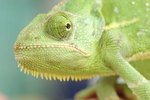
The American alligator (Alligator mississippiensis), along with the other 25 crocodilians living today, is heavily adapted to life in a watery environment. Many of his specializations have to do with his eyes, since in order to hunt successfully he must be able to see both on land and underwater.
Placement
The alligator's eyes, along with his nostrils and ears, are placed on top of his head. This allows the gator to glide along with most of his body under the surface, where his prey cannot see him approaching. There is, however, a downside to this placement: Because a gator's eyes face the sides instead of straight ahead, he has a blind spot in the front and center of his field of vision, just like a chicken. That's why a human can place a hand, or even a head, in the gator's open mouth without being bitten -- it's just a matter of finding the right spot.
Structure
A gator's eyes are large for his body size and are actually mobile in the socket; the gator can pull his eyes back and down into the bony skull if they are threatened and then push them back out when the danger has passed. His cornea is flat instead of curved, but the lens is almost round, like a fish's. Like many animals, gators have a lining in the back of the eye that reflects the light coming in through the pupil. This increases the gator's ability to see in low-light situations, such as muddy water or darkness -- but it also causes his eyes to shine red at night, giving away his location. It even allows an interested observer to guesstimate his size: 1 inch of space between a gator's eyes usually means 1 foot of body length.
Pupil
The gator has a vertical or up-and-down pupil, like a cat, that he can close completely in bright light but expand to a full circle in low light. This allows him to bask in the sun to get warm -- he has no internal thermostat -- without damaging the delicate structures inside his eyeball. His pupil is always 90 degrees to the horizon except when he gets flipped onto his back. This move discombobulates both his vision and his balance, and he freezes, unable to see and with no idea which way is up.
Eyelids
Humans have only one set of eyelids on each eye, but the gator has two. His outer eyelids match his skin and close from the top and bottom to meet in the middle, like ours, but his inner ones close from side to side, starting at the inside corner, when he submerges. The important thing about these inner lids is that they are crystal clear; it's like he puts on a pair of goggles that keep water from blurring his vision and debris from hitting his eyes. This lets him catch fish and anything else swimming on or under the surface.
References
Resources
Photo Credits
-
Photos.com/Photos.com/Getty Images




